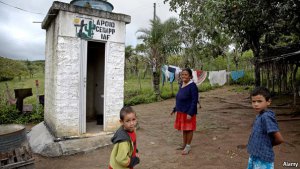IF WATER has the capacity to enhance life, its absence has the capacity to make it miserable. David Gray, a water practitioner who has served the World Bank in almost every river basin on the globe and is now a professor at Oxford, has a technique that makes the point. Every day he receives e-mails with water stories from newspapers round the world. By briefly displaying to an audience just one day’s crop—including, say, drought in Australia, floods in Kenya, an empty dam in Pakistan, a toxic spill in the Yellow river and saltwater contamination in Haiti—he can soon show how water may dominate if not destroy lives, especially in poor countries. 
Some of its most pernicious influences, though, never make the headlines. This is how they might read: “Over 1.2 billion people have to defecate in the open.” “The biggest single cause of child deaths is diarrhoea or diseases related to it.” “Nearly 1 billion people have no access to piped drinking water or safe taps or wells.” Each of these statements is linked to water.
Surprisingly, some of those who have to defecate in the open do not mind. Some rural men, and even women, quite enjoy a social squat in the bushes. But for many, and certainly for those who must live with its consequences, it is a disagreeable practice. Women and, especially, girls often find it embarrassing. Many women in South Asia contain themselves by day and wait till nightfall before venturing into the shadows. Girls at African schools without latrines often drop out rather than risk the jeers of their male contemporaries. Slum-dwellers in Nairobi have to pick their way through streams of sewage and take care to avoid “flying toilets”, plastic bags filled with excrement that are flung with desperate abandon into the night.
Without piped water to wash their hands with, let alone to drink, the open-air defecators and another 800m people with access only to primitive latrines are inevitably carriers of disease. If they could wash their hands with soap and water, they could block one of the main transmission routes for the spread of both diarrhoeal diseases and respiratory infections. As it is, patients with water-related diseases fill half the hospital beds in the poorest countries, and dirty water and poor sanitation kill 5,000 children a day.
Clean water is crucial for children with diarrhoea; they need rehydration and electrolytes to survive. Even then, they may still be at risk of malnutrition if they continue to suffer from diarrhoea, which will prevent them from absorbing their food properly. This usually has long-term consequences. Malnutrition in the womb and during the first two years of life is now seen as causing irreversible changes that lead to lifelong poor health.
Poor health, bad in itself, translates into poor economic output. A study in Guatemala followed the lives of children in four villages from their earliest years to ages between 25 and 42. In two villages the children were given a nutritious supplement for their first seven years, and in the other pair a less nutritious one. The boys who had had the more nutritious diet in their first two years were found to have larger bodies, a greater capacity for physical work, more schooling and better cognitive skills. They also grew up to earn average wages 46% higher than the other groups.
Studies in Ghana and Pakistan suggest that the long-term impact of malnutrition associated with diarrhoeal infections costs each country 4-5% of GDP. This can be added to a similar burden for “environmental risk”, which includes malaria and poor access to water and sanitation, both water- related, as well as indoor air pollution. All in all, the World Health Organisation thinks that half the consequences of malnutrition are caused by inadequate water, sanitation and hygiene. In Ghana and Pakistan the total cost of these shortcomings may amount to 9% of GDP, and these two countries are not unique.





